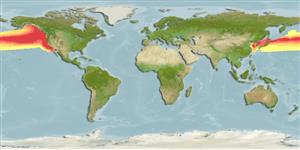>
Myctophiformes (Lanternfishes) >
Myctophidae (Lanternfishes) > Myctophinae
Etymology: Tarletonbeania: Because of Tarleton H. Bean, fisrt curator of fishes in Smithsonian Institut; 1846-1916; crenularis: From the Latin crenula which means small notch - referring to the slightly scalloped edges of the scale..
More on authors: Jordan & Gilbert.
Environment: milieu / climate zone / depth range / distribution range
Ecología
marino batipelágico; rango de profundidad 0 - 710 m (Ref. 6885). Deep-water; 66°N - 28°N
Eastern Pacific: southeastern Alaska to off Mexico, including the Gulf of Alaska and Bering Sea (Ref. 31442).
Tamaño / Peso / Age
Maturity: Lm ? range ? - ? cm
Max length : 12.7 cm TL macho / no sexado; (Ref. 4925)
Short description
Claves de identificación | Morfología | Morfometría
Espinas dorsales (total) : 0; Radios blandos dorsales (total) : 11 - 14; Espinas anales: 0; Radios blandos anales: 17 - 20; Vértebra: 39 - 42. Adipose fin small, short based, and slender; pelvic fins with 8 or 9 rays, including rudimentary ray (Ref. 6885). Bright metallic blue dorsally, bright silvery ventrally (Ref. 6885). Branchiostegal rays: 8-9 (Ref. 31442).
Epipelagic to mesopelagic, found at the surface at night (Ref. 31442). Feed on euphausiids (Ref. 6885). Oviparous, with planktonic eggs and larvae (Ref. 31442). Lipid content is 2.1 % in fresh body weight and wax ester is, at the most, 5 % in total lipids (Ref. 9197).
Life cycle and mating behavior
Maturities | Reproducción | Spawnings | Egg(s) | Fecundities | Larva
Hart, J.L., 1973. Pacific fishes of Canada. Bull. Fish. Res. Board Can. 180:740 p. (Ref. 6885)
IUCN Red List Status (Ref. 130435)
Threat to humans
Harmless
Human uses
Herramientas
Special reports
Download XML
Fuentes de Internet
Estimates based on models
Preferred temperature (Ref.
123201): 1.8 - 9.3, mean 6.2 °C (based on 129 cells).
Phylogenetic diversity index (Ref.
82804): PD
50 = 0.7500 [Uniqueness, from 0.5 = low to 2.0 = high].
Bayesian length-weight: a=0.00871 (0.00387 - 0.01962), b=3.11 (2.92 - 3.30), in cm total length, based on LWR estimates for this (Sub)family-body shape (Ref.
93245).
Nivel trófico (Ref.
69278): 3.1 ±0.32 se; based on food items.
Resiliencia (Ref.
120179): Alto, población duplicada en un tiempo mínimo inferior a 15 meses (Preliminary K or Fecundity.).
Fishing Vulnerability (Ref.
59153): Low vulnerability (10 of 100).
